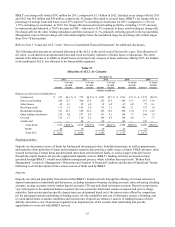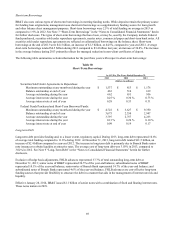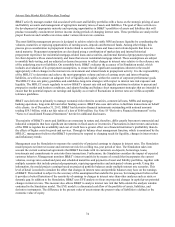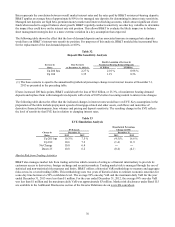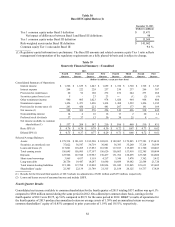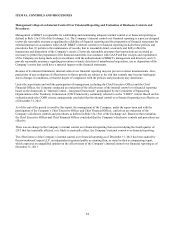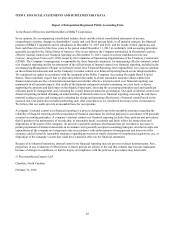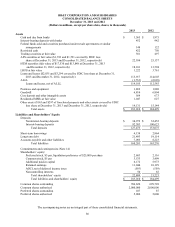BB&T 2013 Annual Report Download - page 77
Download and view the complete annual report
Please find page 77 of the 2013 BB&T annual report below. You can navigate through the pages in the report by either clicking on the pages listed below, or by using the keyword search tool below to find specific information within the annual report.
77
Liquidity
Liquidity represents the continuing ability to meet funding needs, including deposit withdrawals, timely repayment of
borrowings and other liabilities, and funding of loan commitments. In addition to the level of liquid assets, such as cash, cash
equivalents and AFS securities, many other factors affect the ability to meet liquidity needs, including access to a variety of
funding sources, maintaining borrowing capacity in national money markets, growing core deposits, the repayment of loans
and the ability to securitize or package loans for sale. BB&T monitors key liquidity metrics at both the Parent Company and
Branch Bank.
Parent Company
The purpose of the Parent Company is to serve as the primary capital financing vehicle for the operating subsidiaries. The
assets of the Parent Company consist primarily of cash on deposit with Branch Bank, equity investments in subsidiaries,
advances to subsidiaries, accounts receivable from subsidiaries, and other miscellaneous assets. The principal obligations of
the Parent Company are principal and interest payments on long-term debt. The main sources of funds for the Parent
Company are dividends and management fees from subsidiaries, repayments of advances to subsidiaries, and proceeds from
the issuance of equity and long-term debt. The primary uses of funds by the Parent Company are for investments in
subsidiaries, advances to subsidiaries, dividend payments to common and preferred shareholders, retirement of common
stock and interest and principal payments due on long-term debt.
The primary source of funds used for Parent Company cash requirements was dividends received from subsidiaries, which
totaled $1.3 billion during 2013. In addition, the Parent Company issued $1.0 billion of senior notes and repaid $500 million
of maturing long-term debt. Funds raised through master note agreements with commercial clients are placed in a note
receivable at Branch Bank primarily for its use in meeting short-term funding needs and, to a lesser extent, to support the
short-term temporary cash needs of the Parent Company. At December 31, 2013 and 2012, master note balances totaled $24
million and $37 million, respectively.
Liquidity at the Parent Company is more susceptible to market disruptions. BB&T prudently manages cash levels at the
Parent Company to cover a minimum of one year of projected contractual cash outflows which includes unfunded external
commitments, debt service, preferred dividends and scheduled debt maturities without the benefit of any new cash infusions.
Generally, BB&T maintains a significant buffer above the projected one year of contractual cash outflows. In determining the
buffer, BB&T considers cash for common dividends, unfunded commitments to affiliates, being a source of strength to its
banking subsidiaries, and being able to withstand sustained market disruptions which may limit access to the capital markets.
As of December 31, 2013 and December 31, 2012, the Parent Company had 27 months and 35 months, respectively, of cash
on hand to satisfy projected contractual cash outflows as described above.
Branch Bank
BB&T carefully manages liquidity risk at Branch Bank. Branch Bank’s primary source of funding is customer deposits.
Continued access to customer deposits is highly dependent on the confidence the public has in the stability of the bank and its
ability to return funds to the client when requested. BB&T maintains a strong focus on its reputation in the market to ensure
continued access to client deposits. BB&T integrates its risk appetite into its overall risk management framework to ensure
the bank does not exceed its risk tolerance through its lending and other risk taking functions and thus risk becoming
undercapitalized. BB&T believes that sufficient capital is paramount to maintaining the confidence of its depositors and other
funds providers. BB&T has extensive capital management processes in place to ensure it maintains sufficient capital to
absorb losses and maintain a highly capitalized position that will instill confidence in the bank and allow continued access to
deposits and other funding sources. Branch Bank monitors many liquidity metrics at the bank including funding
concentrations, diversification, maturity distribution, contingent funding needs and ability to meet liquidity requirements
under times of stress.
Branch Bank has several major sources of funding to meet its liquidity requirements, including access to capital markets
through issuance of senior or subordinated bank notes and institutional CDs, access to the FHLB system, dealer repurchase
agreements and repurchase agreements with commercial clients, access to the overnight and term Federal funds markets, use
of a Cayman branch facility, access to retail brokered CDs and a borrower in custody program with the FRB for the discount
window. As of December 31, 2013, BB&T has approximately $57.3 billion of secured borrowing capacity, which represents
approximately 357% of one year wholesale funding maturities.


